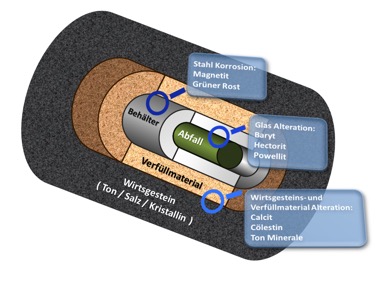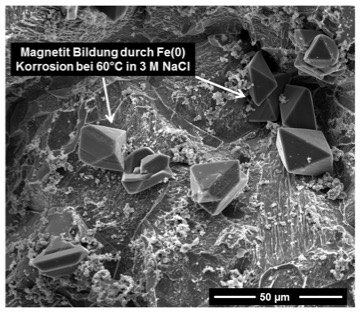Secondary phases
High-level nuclear waste (HLW), either as spent nuclear fuel or as vitrified waste, is foreseen to be disposed of in a deep geological repository. In such a repository, HLW will be encapsulated in metallic canisters and surrounded by multiple technical and geotechnical barriers. During the (geo)chemical evolution of this multi-barrier system, ground water migration through the barriers and potentially reaching the waste packages need to be considered. In aqueous environments, components of the multi-barrier system will undergo alteration and degradation processes, metallic canisters will corrode and following failure, the waste matrix itself will start to alter, resulting in the formation of secondary phases via dissolution and subsequent re-precipitation. For example, iron (hydr)oxides will form upon steel canister corrosion, sheet silicates, calcium molybdate or barium sulfate are expected to form upon HLW glass alteration. Such secondary phases have the potential to scavenge radionuclides (RN) released upon waste matrix alteration and to retard their migration to the biosphere. Various molecular scale retention mechanisms, from surface adsorption to structural incorporation, can result in effective RN immobilization. Among these processes, structural incorporation by the formation of solid solutions is argued to lead to a substantial retention in the near field. However, despite the abundance of solid solutions in natural systems, reliable kinetic and thermodynamic models to predict their formation are hardly available.
The aims of the INE Secondary Phases group are to obtain a molecular scale process understanding of secondary phase formation in environments typical for HLW repositories by complementing experiments in the laboratory with participation in in-situ underground research laboratory experiments (e.g., metal corrosion), and to develop thermodynamic and kinetic models for the prediction of RN retention by solid solution formation. Molecular scale information is gained by application of advanced spectroscopy, diffraction, and microscopy techniques (e.g., X-ray absorption and X-ray diffraction-based methods, electron microscopies, atomic force microscopy) in combination with advanced computational efforts. The ultimate goal is to provide thermodynamic and kinetic data and models, which allow to improve the accuracy and precision of performance assessment calculations and the Safety Case for deep geological HLW repositories.
Investigations are carried out largely in the frame of national and international projects funded by waste management agencies, the European Commission, or by German Federal Ministries.
Contact:
| +49 721 608 24321 | +49 721 608 24782 |


